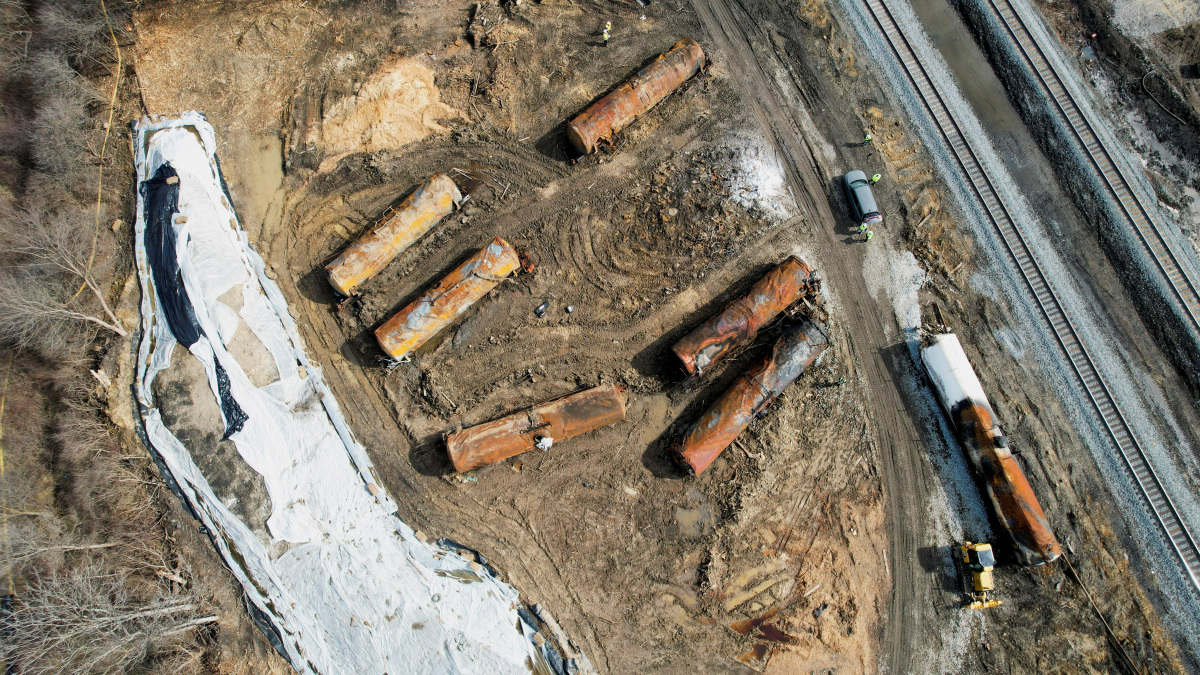Toxic Chemical Residue From Ohio Train Derailment: A Building Contamination Investigation

Table of Contents
Identifying Potential Sources of Contamination
Chemical Spill Assessment
The Ohio train derailment involved the release of several hazardous materials, posing significant risks to nearby buildings. Key chemicals involved include vinyl chloride, a known carcinogen, and butyl acrylate, an irritant and potential respiratory hazard. Understanding how these chemicals can enter buildings is critical.
- Airborne Contamination: Volatile chemicals like vinyl chloride can easily evaporate and enter buildings through ventilation systems, windows, and cracks in the structure.
- Water Runoff: Rainwater can carry dissolved chemicals into basements and contaminate building water supplies.
- Soil Contamination: Chemicals absorbed into the soil can leach into building foundations, potentially contaminating indoor air and water sources through vapor intrusion or groundwater migration.
The known health effects of these chemicals highlight the urgent need for comprehensive investigation. Vinyl chloride exposure is linked to liver cancer and other serious health problems, while butyl acrylate can cause skin, eye, and respiratory irritation. This necessitates immediate action to assess and mitigate any potential contamination.
Assessing Building Vulnerability
The vulnerability of a building to contamination depends on several factors:
- Building Age: Older buildings with less efficient sealing and ventilation systems may be more susceptible to contamination.
- Ventilation Systems: Buildings with poorly maintained or inadequate ventilation systems are at greater risk of airborne chemical infiltration. Conversely, well-maintained HVAC systems can help to reduce indoor air pollution, if they are properly designed and managed.
- Proximity to the Derailment Site: Buildings closer to the derailment site are obviously at a higher risk of contamination, due to the higher concentration of released chemicals.
- Building Materials: Porous building materials like brick and wood can absorb chemicals more readily than non-porous materials like concrete or metal. This impacts the ability to clean the structures after a chemical spill.
A thorough risk assessment, considering these factors, is essential to prioritize buildings for investigation.
Investigating Building Contamination
Sampling and Testing Procedures
Investigating building contamination requires rigorous sampling and testing procedures. Samples must be collected carefully from various sources:
- Air Samples: Collected using specialized pumps and filters to measure airborne chemical concentrations.
- Water Samples: Collected from taps, wells, and other water sources to test for dissolved chemicals.
- Soil Samples: Collected around building foundations to determine soil contamination levels.
- Surface Wipes: Used to detect chemicals on surfaces within the building.
Analytical techniques such as Gas Chromatography-Mass Spectrometry (GC-MS) and High-Performance Liquid Chromatography (HPLC) are used to identify and quantify the specific chemicals present. Utilizing accredited laboratories ensures the accuracy and reliability of test results. The choice of sampling method and laboratory testing must be specific to the type of suspected chemical contamination.
Data Analysis and Interpretation
Once the samples are analyzed, the data must be carefully interpreted to determine the extent and severity of contamination. This involves:
- Comparison to Regulatory Limits: Test results are compared to established regulatory limits and thresholds for the chemicals involved. Exceeding these limits indicates a need for remediation.
- Exposure Assessment: Data is used to assess the potential for human exposure to the chemicals, considering factors like duration and intensity of exposure.
- Health Risk Assessment: This assessment determines the potential health effects associated with the levels of detected contamination. This assessment can then inform decisions about necessary mitigation and remediation steps.
Accurate data analysis is critical for making informed decisions regarding remediation and public health.
Remediation and Mitigation Strategies
Decontamination Techniques
Several techniques can be used to remove or reduce chemical residues from buildings:
- Air Scrubbing: Utilizing specialized air filtration systems to remove airborne contaminants.
- Surface Cleaning: Cleaning and decontaminating surfaces using appropriate cleaning agents and protocols.
- Soil Remediation: Excavating and treating contaminated soil around building foundations.
- Specialized Treatments: Depending on the chemicals present and the nature of the contamination, more advanced treatments may be required to neutralize or remove them.
The choice of decontamination techniques depends on the specific chemicals involved, the extent of contamination, and the building's construction materials. Safety precautions are paramount during all decontamination processes to protect workers and prevent further contamination.
Long-Term Monitoring and Prevention
Effective remediation requires long-term monitoring to ensure the effectiveness of the chosen techniques and to detect any potential resurgence of contamination. This includes:
- Regular Sampling and Testing: Periodic testing of air, water, and soil samples.
- Community Engagement: Open communication with residents to address concerns and provide updates.
- Preventative Measures: Implementing building design and maintenance practices to minimize future contamination risks. This might include improving building ventilation or using less porous materials.
Promoting sustainable practices and investing in resilient infrastructure will help prevent similar incidents and mitigate the risks associated with toxic chemical residue in the future.
Conclusion
Investigating toxic chemical residue from the Ohio train derailment in buildings is a complex process requiring a multi-faceted approach. Identifying potential sources, conducting thorough testing, and implementing effective remediation strategies are crucial steps in protecting public health and the environment. The ongoing investigation highlights the need for robust regulations and safety measures to prevent future incidents and ensure building safety. If you suspect building contamination related to the Ohio train derailment, contact qualified professionals to investigate potential building contamination and address any toxic chemical residue concerns. Let's work together to ensure the safety of our communities and advocate for stricter regulations to prevent future tragedies and address toxic chemical residue contamination effectively.

Featured Posts
-
 Get Ready For Sinners Louisiana Filmed Horror Movie Arrives In Theaters
May 29, 2025
Get Ready For Sinners Louisiana Filmed Horror Movie Arrives In Theaters
May 29, 2025 -
 Elon Musks Starbase A New City Takes Shape In Texas
May 29, 2025
Elon Musks Starbase A New City Takes Shape In Texas
May 29, 2025 -
 Can Lula Convince Putin To Meet Zelenskyy In Istanbul
May 29, 2025
Can Lula Convince Putin To Meet Zelenskyy In Istanbul
May 29, 2025 -
 Space Xs April 7th Starlink Launch 27 Satellites Added To Constellation
May 29, 2025
Space Xs April 7th Starlink Launch 27 Satellites Added To Constellation
May 29, 2025 -
 Who Is Claude Meet The Netherlands Eurovision 2025 Song Contest Entry
May 29, 2025
Who Is Claude Meet The Netherlands Eurovision 2025 Song Contest Entry
May 29, 2025
Latest Posts
-
 Vers Une Reconnaissance Des Droits Du Vivant L Histoire Des Etoiles De Mer
May 31, 2025
Vers Une Reconnaissance Des Droits Du Vivant L Histoire Des Etoiles De Mer
May 31, 2025 -
 Le Cas Des Etoiles De Mer Plaidoyer Pour Une Reconnaissance Des Droits Du Vivant
May 31, 2025
Le Cas Des Etoiles De Mer Plaidoyer Pour Une Reconnaissance Des Droits Du Vivant
May 31, 2025 -
 Droits Du Vivant Le Cas Emblematique De L Etoile De Mer
May 31, 2025
Droits Du Vivant Le Cas Emblematique De L Etoile De Mer
May 31, 2025 -
 Etoiles De Mer Un Appel Pour La Justice Environnementale Et Les Droits Du Vivant
May 31, 2025
Etoiles De Mer Un Appel Pour La Justice Environnementale Et Les Droits Du Vivant
May 31, 2025 -
 Justice Pour L Etoile De Mer Un Pas Vers Les Droits Du Vivant
May 31, 2025
Justice Pour L Etoile De Mer Un Pas Vers Les Droits Du Vivant
May 31, 2025
